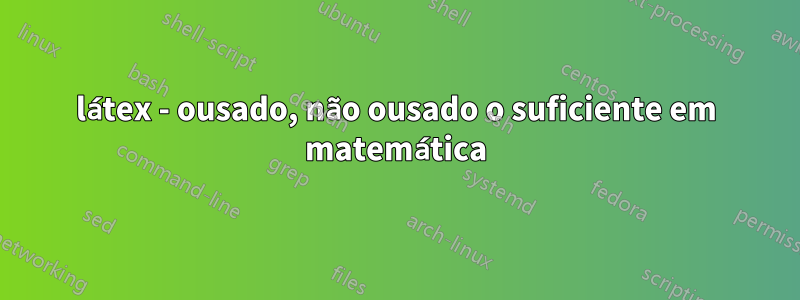
Tentei colocar os caracteres em negrito no ambiente matemático para que ficassem assim (foto tirada de um livro - exemplo de pdf:link):

Porém, nem \mathbf{xyz}funciona \boldsymbol{\mathrm{xyz}}para deixar os personagens ousados o suficiente. Na verdade, é difícil distinguir caracteres em negrito de não negrito. Este é o código que tentei:
\documentclass[english]{scrartcl}
\usepackage[T1]{fontenc}
\usepackage[latin9]{inputenc}
\usepackage{textcomp}
\usepackage{amstext}
\usepackage{babel}
\begin{document}
As an application of these results, consider the case in which $\mathbf{X}_{1}$
is $\mathbf{i}$, a constant term that is a column of 1s in the first
column of $\mathbf{X}$. The solution for $b_{2}$ in this case will
then be the slopes in a regression that contains a constant term.
Using Theorem 3.2 the vector of residuals for any variable in $\mathbf{X}_{2}$
in this case will be
$\mathbf{x\text{\textasteriskcentered}}=\mathbf{x}-\mathbf{X}_{1}(\mathbf{X}_{1}'\mathbf{X}_{1})^{-1}\mathbf{X}_{1}\mathbf{x}$
$\textrm{x\text{\textasteriskcentered}}=\textrm{x}-\textrm{X}_{1}(\textrm{X}_{1}'\textrm{X}_{1})^{-1}\textrm{X}_{1}\textrm{x}$
\end{document}
Existe um truque para obter caracteres "extra-negritos"?
BR Fabian
PS: Eu tentei praticamente todas as propostas de como deixar os personagens ousados que encontrei na internet.
Responder1
O método a seguir funciona apenas em pdflatex. Eu uso um pdf especial para realçar a fonte, chamando-a de \mathbbf[]{}. O argumento opcional permite que um fator de embolsamento opcional seja especificado (padrão 0,2).
No MWE, a linha superior é \mathbbf, a próxima \mathbfe a final é \textrm.
\documentclass[english]{scrartcl}
\usepackage[T1]{fontenc}
\usepackage[latin9]{inputenc}
\usepackage{textcomp}
\usepackage{amstext}
\usepackage{babel}
%%%%%
\usepackage{scalerel,lmodern}
\input pdf-trans
\newbox\qbox
\def\usecolor#1{\csname\string\color@#1\endcsname\space}
\newcommand\outline[1]{\leavevmode%
\def\maltext{#1}%
\setbox\qbox=\hbox{\maltext}%
\boxgs{Q q 2 Tr \thickness\space w 0 0 0 rg 0 G}{}%
\copy\qbox%
}
\newcommand\mathbbf[2][.2]{%
\def\thickness{#1}%
\ThisStyle{\outline{$\mathbf{\SavedStyle#2}$}}%
}
%%%%%
\begin{document}
$\mathbbf{x\text{\textasteriskcentered}}=\mathbbf{x}-\mathbbf{X}_{1}(\mathbbf{X}_{1}'\mathbbf{X}_{1})^{-1}\mathbbf{X}_{1}\mathbbf{x}$
$\mathbf{x\text{\textasteriskcentered}}=\mathbf{x}-\mathbf{X}_{1}(\mathbf{X}_{1}'\mathbf{X}_{1})^{-1}\mathbf{X}_{1}\mathbf{x}$
$\textrm{x\text{\textasteriskcentered}}=\textrm{x}-\textrm{X}_{1}(\textrm{X}_{1}'\textrm{X}_{1})^{-1}\textrm{X}_{1}\textrm{x}$
\end{document}
Responder2
A quantidade de contraste existente entre a fonte em negrito e a média é um aspecto do design da fonte. Você não deu um documento de exemplo. o computador padrão moderno tem contraste razoável entre o peso ousado e o peso médio (o que é fácil, pois o peso médio cm é muito leve)

\documentclass{article}
\usepackage{amsmath}
\begin{document}
$\mathbf{x}\text{\textasteriskcentered}=\mathbf{x}-\mathbf{X}_{1}(\mathbf{X}_{1}^{'}\mathbf{X}_{2}')^{-1}\mathbf{X}'_{1}\mathbf{x}$
$\mathrm{x}\text{\textasteriskcentered}=\mathrm{x}-\mathrm{X}_{1}(\mathrm{X}_{1}^{'}\mathrm{X}_{2}')^{-1}\mathrm{X}'_{1}\mathrm{x}$
\end{document}
Responder3
Uma maneira "suja", que pode funcionar se você estiver usando látex fora das configurações de PDF e, portanto, a resposta de @Steven não puder ser aplicada diretamente, é usar \pmb{}o pacote AMSLatex, em cima do comando negrito, possivelmente aninhado várias vezes.
Abaixo você vê v, \bm{v}, \pmb{\bm{v}}e \pmb{\pmb{\bm{v}}}para a saída Latex da extensão TexMaths do LibreOffice, com a fonte tipo Palatino do newpxtextpacote:




